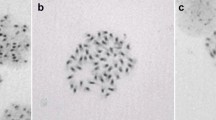Abstract
The karyotype ofCestrum aurantiacum was analyzed for the presence of coldsensitive regions (CSRs) and other types of constitutive heterochromatin. A range of techniques was employed including the fluorescent DAPI, chromomycin/DAPI double staining and actinomycin D/DAPI counter-staining, and the non-fluorescent C-banding applied as single or sequential staining, sequential N-banding and silver impregnation. Four classes of constitutive heterochromatin were recognized: CSRs, nucleolar organizers, non-nucleolar chromomycin-positive bands, and indifferently fluorescent bands. The banded karyotype ofC. aurantiacum is compared with those of otherCestrum species. The sectionsHabrothamnus andCestrum are not karyologically distinct.
Similar content being viewed by others
References
Behr, W., Honikel, K., Hartmann, G., 1969: Interaction of the RNA polymerase inhibitor chromomycin with DNA. — Eur. J. Biochem.9: 82–92.
Berg, C., 1985: Cytochemische Charakterisierung des Heterochromatins, insbesondere des kältesensitiven, beiCestrum (Solanaceae). — Ph.D. Thesis, Vienna.
—, 1992: Cold-sensitive chromosome regions and their relation to constitutive heterochromatin inCestrum parqui (Solanaceae). — Genome35: 921–930.
—, —, 1993: Cold-sensitive chromosome regions and heterochromatin inCestrum (Solanaceae): C. strigillatum, C. fasciculatum, andC. elegans. — Pl. Syst. Evol.185: 133–151.
D'Arcy, W. G., 1973:Solanaceae. — InWoodson, R. E., Schery, R. W., (Eds): Flora of Panama. — Ann. Missouri Bot. Gard.60: 573–780.
—, 1978: A preliminary synopsis ofSalpiglossis and otherCestreae (Solanaceae). — Ann. Missouri Bot. Gard.65: 698–724.
Darlington, C. D., LaCour, L., 1938: Differential reactivity of the chromosomes. — Ann. Bot. n. s.2: 615–625.
—, 1940: Nucleic acid starvation of chromosomes inTrillium. — J. Genet.40: 185–213.
Deumling, B., 1981: Sequence arrangement of a highly methylated satellite DNA of a plant,Scilla: A tandemly repeated inverted repeat. — Proc. Natl. Acad. Sci. USA78: 338–342.
—, 1982: Characterization of heterochromatin in different species of theScilla siberica group (Liliaceae) by in situ hybridization of satellite DNAs and fluorochrome banding. — Chromosoma84: 535–555.
Dyer, A. F., 1963: Allocyclic segments of chromosomes and the structural heterozygosity that they reveal. — Chromosoma13: 545–576.
Francey, P., 1935: Monographie du genreCestrum L. — Candollea6: 46–398.
Fukuda, I., 1984: Chromosome banding and biosystematics. — InGrant, W. F., (Ed.): Plant biosystematics, pp. 97–116. — Orlando: Academic Press.
Funaki, K., Matsui, S., Sasaki, M., 1975: Location of nucleolar organizers in animal and plant chromosomes by means of an improved N-banding technique. — Chromosoma49: 357–370.
Geber, G., Schweizer, D., 1988: Cytochemical heterochromatin differentiation inSinapis alba using a simple air-drying technique for producing chromosome spreads. — Pl. Syst. Evol.158: 97–106.
Geitler, L., 1940: Temperaturbedingte Ausbildung von Spezialsegmenten an Chromosomenenden. — Chromosoma1: 554–561.
Gerlach, W. L., 1977: N-banded karyotypes of wheat species. — Chromosoma62: 49–56.
Greilhuber, J., 1984: Chromosomal evidence in taxonomy. — InHeywood, V. H., Moore, D. M., (Eds): Current concepts in plant taxonomy. — Systematics Ass. Spec. Vol.25: 157–180. — London, Orlando: Academic Press.
Heitz, E., 1928: Das Heterochromatin der Moose. I. — Jahrb. wiss. Bot.69: 762–818.
—, 1929a: Die Herkunft der Chromocentren. Dritter Beitrag zur Kenntnis der Beziehung zwischen Kernstruktur und qualitativer Verschiedenheit der Chromosomen in ihrer Längsrichtung. — Planta18: 571–636.
—, 1929b: Heterochromatin, Chromocentren, Chromomeren. — Ber. Deutsch. Bot. Ges.47: 274–286.
Hunziker, A. T., 1979: South AmericanSolanaceae: a synoptic survey. — InHawkes, J. G., Lester, R. N., Skelding, A. D., (Eds): The biology and taxonomy of theSolanaceae. — Linn. Soc. Symp. Ser.7: 49–85.
Kodama, Y., Yoshida, M. C., Sasaki, M., 1980: An improved silver staining technique for nucleolus organizer regions by using nylon cloth. — Japan. J. Hum. Genet.25: 229–233.
Kumar, V., Subramaniam, B., 1987: Chromosome atlas of flowering plants of the Indian subcontinent. — Botanical Survey of India. — Calcutta: Government of India.
Matsui, S., Sasaki, M., 1973: Differential staining of nucleolus organisers in mammalian chromosomes. — Nature246: 148–150.
Müller, W., Crothers, D. M., 1968: Studies of the binding of actinomycin and related compounds to DNA. — J. Mol. Biol.35: 251–290.
Murray, B. G., Bennett, M. D., Hammett, K. R. W., 1992: Secondary constrictions and NORs ofLathyrus investigated by silver staining and in-situ hybridization. — Heredity68: 473–478.
Sahar, E., Latt, S. A., 1978: Enhancement of banding patterns in human metaphase chromosomes by energy transfer. — Proc. Natl. Acad. Sci. USA75: 5650–5654.
Schwarzacher, T., Schweizer, D., 1982: Karyotype analysis and heterochromatin differentiation with Giemsa C-banding and fluorescent counterstaining inCephalanthera (Orchidaceae). — Pl. Syst. Evol.141: 91–113.
Schweizer, D., 1976a: DAPI fluorescence of plant chromosomes prestained with actinomycin D. — Exp. Cell Res.102: 408–413.
—, 1976b: Reverse fluorescent chromosome banding with chromomycin and DAPI. — Chromosoma58: 307–324.
Sinclair, J. H., Brown, D. D., 1971: Retention of common nucleotide sequences in the ribosomal deoxyribonucleic acid of eukaryotes and some of their physical characteristics. — Biochemistry10: 2761–2769.
Sumner, A. T., 1990: Chromosome banding. — Boston, Sydney, Wellington: Unwin Hyman.
Author information
Authors and Affiliations
Rights and permissions
About this article
Cite this article
Berg, C., Greilhuber, J. Cold-sensitive chromosome regions and heterochromatin inCestrum aurantiacum (Solanaceae). Pl Syst Evol 185, 259–273 (1993). https://doi.org/10.1007/BF00937662
Received:
Revised:
Accepted:
Issue Date:
DOI: https://doi.org/10.1007/BF00937662




